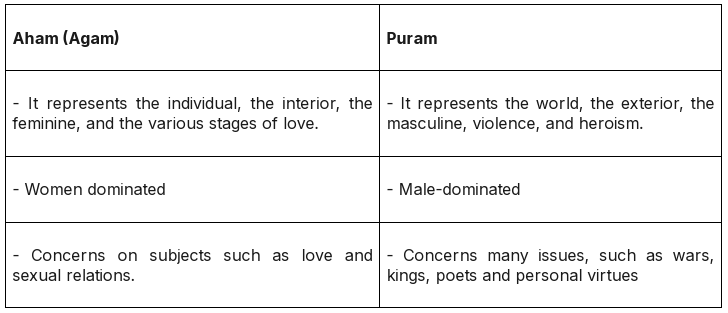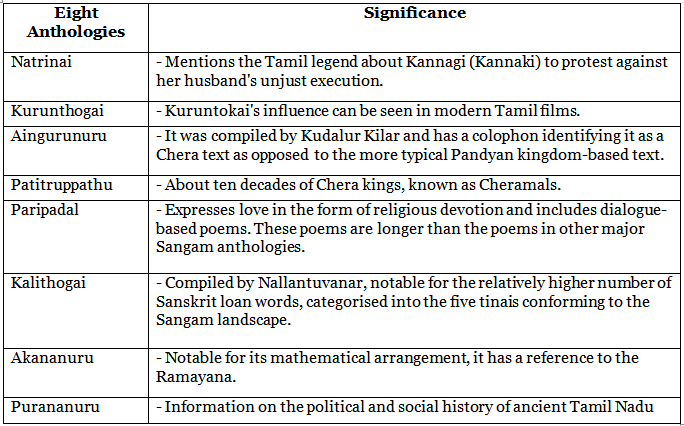Literature: The Sangam Age | History for UPSC CSE PDF Download
| Table of contents |

|
| The Sangam Literature |

|
| Early Sangam Literature |

|
| Later Sangam Literature |

|
| Other Literary Sources of the Sangam Age |

|
The Sangam Literature
The Ancient Tamil Siddhar Agastyar is traditionally believed to have chaired the first Tamil Sangam in Madurai.
 The Sangam Literature
The Sangam Literature
- Tamil scholars believe that there were three Sangams, or academies of Tamil poets, in ancient Tamil Nadu, which is also called Muchchangam. These Sangams thrived under the patronage of the Pandyan dynasty. The Tamil literary works from this period are still considered valuable for rewriting the history of the Sangam age.
- First Sangam: The first Sangam was said to be attended by legendary gods and sages and was held in Madurai. However, there are no recorded accounts of this event.
- Second Sangam: The second Sangam took place in Kapadapuram, Tamil Nadu. Apart from Tolkappiyam, none of the literary works from this Sangam have survived.
- Third Sangam: The third Sangam was established in Madurai by Mudathirumaran. Many poets participated and created significant works, but only a few have survived.
The works included in the Sangam literature corpus are:
- Tolkappiyam
- Ettutogai
- Pattuppattu
- Pathinenkilkanakku
- Silappathigaram
- Manimegalai
Pathinen Melkanakku includes Ettutogai and Pattuppattu
Early Sangam Literature
The earliest Sangam literature offers precious glimpses into the social, cultural, and literary dimensions of ancient South India. This body of work includes texts such as Agattiyam, Tolkappiyam, Ettuttogai, and Pattuppattu.Aham and Puram Concept
In Sangam literature, the poetic form holds significant importance. Tholkappiyam, an ancient Tamil treatise, classifies poetry into two categories: Aham and Puram. These categories, while being polar opposites, also complement each other in the realm of poetry.

Agattiyam (Akattiyam)
- According to Tamil tradition, Agattiyam is believed to be the earliest book on Tamil grammar.
- This text, written and compiled by sage Agattiar (Agastya) during the First Sangam, is considered a non-extant work, meaning it no longer exists.
Tolkappiyam
- Tolkappiyam, authored by Tolkappiyar, is regarded as the first literary work in Tamil.
- It is mentioned in Iraiyanar's Akapporul as an authoritative text on Tamil grammar.
- Tolkappiyam is the oldest Tamil grammar text and the earliest long work of Tamil literature that is still extant.
- The work is divided into three sections: Eluttatikaram, Sollatikaram, and Porulatikaram.
- Tolkappiyam also provides insights into the political and socio-economic conditions of its time.
Ettuttogai
- Ettuttogai is a classical Tamil poetic compilation consisting of eight works, both long and short.
- It is included in the Pathinen Melkanakku, which is a collection of Eighteen Greater Texts.

Pattuppattu
It is an anthology of ten longer poems in the Sangam literature – the earliest known Tamil literature. 
Later Sangam Literature
The Sangam age was a period of remarkable literary achievement, characterized by the flourishing of poets and scholars who contributed to a vibrant literary tradition. The works produced during this era are still highly regarded today for their poetic excellence, imaginative storytelling, and cultural significance.Patinen Kilkanakku, also known as “The Eighteen Lesser Texts,” is a collection of eighteen poetic works created during the post-Sangam period. These texts primarily focus on themes of morals and ethics.

Five Great Epics
- According to later Tamil literary tradition, these epics are extensive narrative works that hold significant cultural and literary value.

Other Literary Sources of the Sangam Age
- Greek authors such as Megasthenes, Pliny, Strabo, and Ptolemy noted the commercial connections between the West and South India.
- Asokan inscriptions refer to the Chera, Chola, and Pandya kings in the southern part of the Mauryan empire.
- The Hathigumpha inscription by Kharavela of Kalinga also makes mention of the Tamil kingdoms.
|
216 videos|855 docs|219 tests
|
FAQs on Literature: The Sangam Age - History for UPSC CSE
| 1. What is Sangam Literature and what are its characteristics? |  |
| 2. Who were the poets of the Sangam period? |  |
| 3. What are the major themes found in Sangam Literature? |  |
| 4. How does Sangam Literature reflect the social and cultural life of the Tamil people? |  |
| 5. What are some of the notable works of Sangam Literature? |  |





















